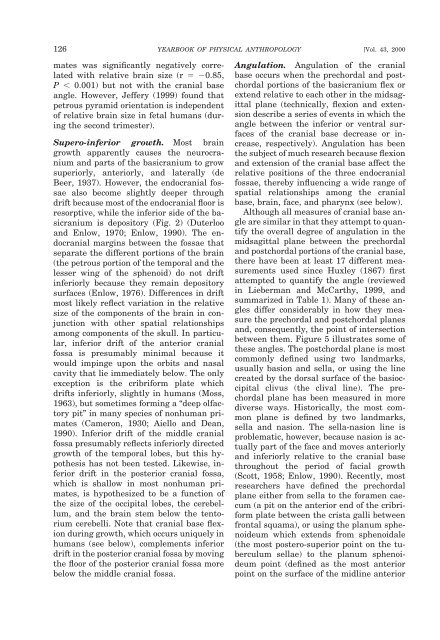The primate cranial base: ontogeny, function and - Harvard University
The primate cranial base: ontogeny, function and - Harvard University
The primate cranial base: ontogeny, function and - Harvard University
Create successful ePaper yourself
Turn your PDF publications into a flip-book with our unique Google optimized e-Paper software.
126 YEARBOOK OF PHYSICAL ANTHROPOLOGY [Vol. 43, 2000<br />
mates was significantly negatively correlated<br />
with relative brain size (r 0.85,<br />
P 0.001) but not with the <strong>cranial</strong> <strong>base</strong><br />
angle. However, Jeffery (1999) found that<br />
petrous pyramid orientation is independent<br />
of relative brain size in fetal humans (during<br />
the second trimester).<br />
Supero-inferior growth. Most brain<br />
growth apparently causes the neurocranium<br />
<strong>and</strong> parts of the basicranium to grow<br />
superiorly, anteriorly, <strong>and</strong> laterally (de<br />
Beer, 1937). However, the endo<strong>cranial</strong> fossae<br />
also become slightly deeper through<br />
drift because most of the endo<strong>cranial</strong> floor is<br />
resorptive, while the inferior side of the basicranium<br />
is depository (Fig. 2) (Duterloo<br />
<strong>and</strong> Enlow, 1970; Enlow, 1990). <strong>The</strong> endo<strong>cranial</strong><br />
margins between the fossae that<br />
separate the different portions of the brain<br />
(the petrous portion of the temporal <strong>and</strong> the<br />
lesser wing of the sphenoid) do not drift<br />
inferiorly because they remain depository<br />
surfaces (Enlow, 1976). Differences in drift<br />
most likely reflect variation in the relative<br />
size of the components of the brain in conjunction<br />
with other spatial relationships<br />
among components of the skull. In particular,<br />
inferior drift of the anterior <strong>cranial</strong><br />
fossa is presumably minimal because it<br />
would impinge upon the orbits <strong>and</strong> nasal<br />
cavity that lie immediately below. <strong>The</strong> only<br />
exception is the cribriform plate which<br />
drifts inferiorly, slightly in humans (Moss,<br />
1963), but sometimes forming a “deep olfactory<br />
pit” in many species of nonhuman <strong>primate</strong>s<br />
(Cameron, 1930; Aiello <strong>and</strong> Dean,<br />
1990). Inferior drift of the middle <strong>cranial</strong><br />
fossa presumably reflects inferiorly directed<br />
growth of the temporal lobes, but this hypothesis<br />
has not been tested. Likewise, inferior<br />
drift in the posterior <strong>cranial</strong> fossa,<br />
which is shallow in most nonhuman <strong>primate</strong>s,<br />
is hypothesized to be a <strong>function</strong> of<br />
the size of the occipital lobes, the cerebellum,<br />
<strong>and</strong> the brain stem below the tentorium<br />
cerebelli. Note that <strong>cranial</strong> <strong>base</strong> flexion<br />
during growth, which occurs uniquely in<br />
humans (see below), complements inferior<br />
drift in the posterior <strong>cranial</strong> fossa by moving<br />
the floor of the posterior <strong>cranial</strong> fossa more<br />
below the middle <strong>cranial</strong> fossa.<br />
Angulation. Angulation of the <strong>cranial</strong><br />
<strong>base</strong> occurs when the prechordal <strong>and</strong> postchordal<br />
portions of the basicranium flex or<br />
extend relative to each other in the midsagittal<br />
plane (technically, flexion <strong>and</strong> extension<br />
describe a series of events in which the<br />
angle between the inferior or ventral surfaces<br />
of the <strong>cranial</strong> <strong>base</strong> decrease or increase,<br />
respectively). Angulation has been<br />
the subject of much research because flexion<br />
<strong>and</strong> extension of the <strong>cranial</strong> <strong>base</strong> affect the<br />
relative positions of the three endo<strong>cranial</strong><br />
fossae, thereby influencing a wide range of<br />
spatial relationships among the <strong>cranial</strong><br />
<strong>base</strong>, brain, face, <strong>and</strong> pharynx (see below).<br />
Although all measures of <strong>cranial</strong> <strong>base</strong> angle<br />
are similar in that they attempt to quantify<br />
the overall degree of angulation in the<br />
midsagittal plane between the prechordal<br />
<strong>and</strong> postchordal portions of the <strong>cranial</strong> <strong>base</strong>,<br />
there have been at least 17 different measurements<br />
used since Huxley (1867) first<br />
attempted to quantify the angle (reviewed<br />
in Lieberman <strong>and</strong> McCarthy, 1999, <strong>and</strong><br />
summarized in Table 1). Many of these angles<br />
differ considerably in how they measure<br />
the prechordal <strong>and</strong> postchordal planes<br />
<strong>and</strong>, consequently, the point of intersection<br />
between them. Figure 5 illustrates some of<br />
these angles. <strong>The</strong> postchordal plane is most<br />
commonly defined using two l<strong>and</strong>marks,<br />
usually basion <strong>and</strong> sella, or using the line<br />
created by the dorsal surface of the basioccipital<br />
clivus (the clival line). <strong>The</strong> prechordal<br />
plane has been measured in more<br />
diverse ways. Historically, the most common<br />
plane is defined by two l<strong>and</strong>marks,<br />
sella <strong>and</strong> nasion. <strong>The</strong> sella-nasion line is<br />
problematic, however, because nasion is actually<br />
part of the face <strong>and</strong> moves anteriorly<br />
<strong>and</strong> inferiorly relative to the <strong>cranial</strong> <strong>base</strong><br />
throughout the period of facial growth<br />
(Scott, 1958; Enlow, 1990). Recently, most<br />
researchers have defined the prechordal<br />
plane either from sella to the foramen caecum<br />
(a pit on the anterior end of the cribriform<br />
plate between the crista galli between<br />
frontal squama), or using the planum sphenoideum<br />
which extends from sphenoidale<br />
(the most postero-superior point on the tuberculum<br />
sellae) to the planum sphenoideum<br />
point (defined as the most anterior<br />
point on the surface of the midline anterior
















